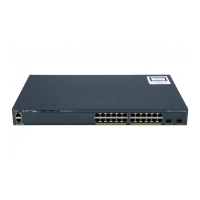Chapter 14: Voice 255
Section 14-2
■ Normal PCs with no voice capability should be untrusted (CoS and type of service
[ToS] set to 0).
■ On Catalyst 6000 switches, port trust can be VLAN-based and applied to the voice
VLAN on all trusted ports.
■ Modify the CoS and ToS to DSCP maps so that 3 maps to DSCP 26 (AF31) and 5
maps to DSCP 46 (EF), where possible.
■ Uplinks into the distribution and core layers should trust DSCP values, if possible.
■ Schedule egress voice frames with CoS 3 to be assigned to the higher-priority queue.
Frames with CoS 5 are automatically assigned to the strict-priority egress queue.
■ Distribution and core layers.
■ If the DSCP values can be controlled by the access layer switches, trust them on
those ports.
■ If the access layer switches are Layer 2-only and cannot classify or mark frames based
on DSCP, set the DSCP values for voice frames in the higher-layer switches. This can
be done on a voice VLAN for ports that are configured for VLAN-based trust.
■ Modify the CoS and ToS to DSCP maps so that 3 maps to DSCP 26 (AF31) and 5
maps to DSCP 46 (EF), where possible.
■ Schedule egress voice frames with CoS 3 to be assigned to the higher-priority queue.
Frames with CoS 5 are automatically assigned to the strict-priority egress queue.
You can use several voice protocols within a network:
■ Voice control protocols: Protocols that are used to register and set up calls:
■ Skinny Client Control Protocol (SCCP), also known as Simple Client Control
Protocol
■ H.323
■ Session Initiation Protocol (SIP)
■ Media Gateway Control Protocol (MGCP)
■ Megaco or H.248
■ Real-Time Transport Protocol (RTP): The UDP encapsulation of the actual voice-
bearer packets. All voice protocols use RTP as the transport mechanism after a call
has been established.
These voice protocols use the UDP or TCP port numbers shown in Table 14-2. These val-
ues can come in handy when you need to classify voice traffic for QoS in a Catalyst
switch. Each of the voice-call control protocols should be marked as CoS 3 or DSCP 26
(AF31). The RTP voice-bearer packets should always be marked as CoS 5 or DSCP 46
(EF) to ensure timely delivery. RTP packet marking is usually done at the source by
definition.

